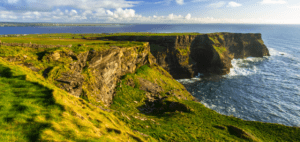Exploring the Passionate Iberian Music: Fado and Flamenco
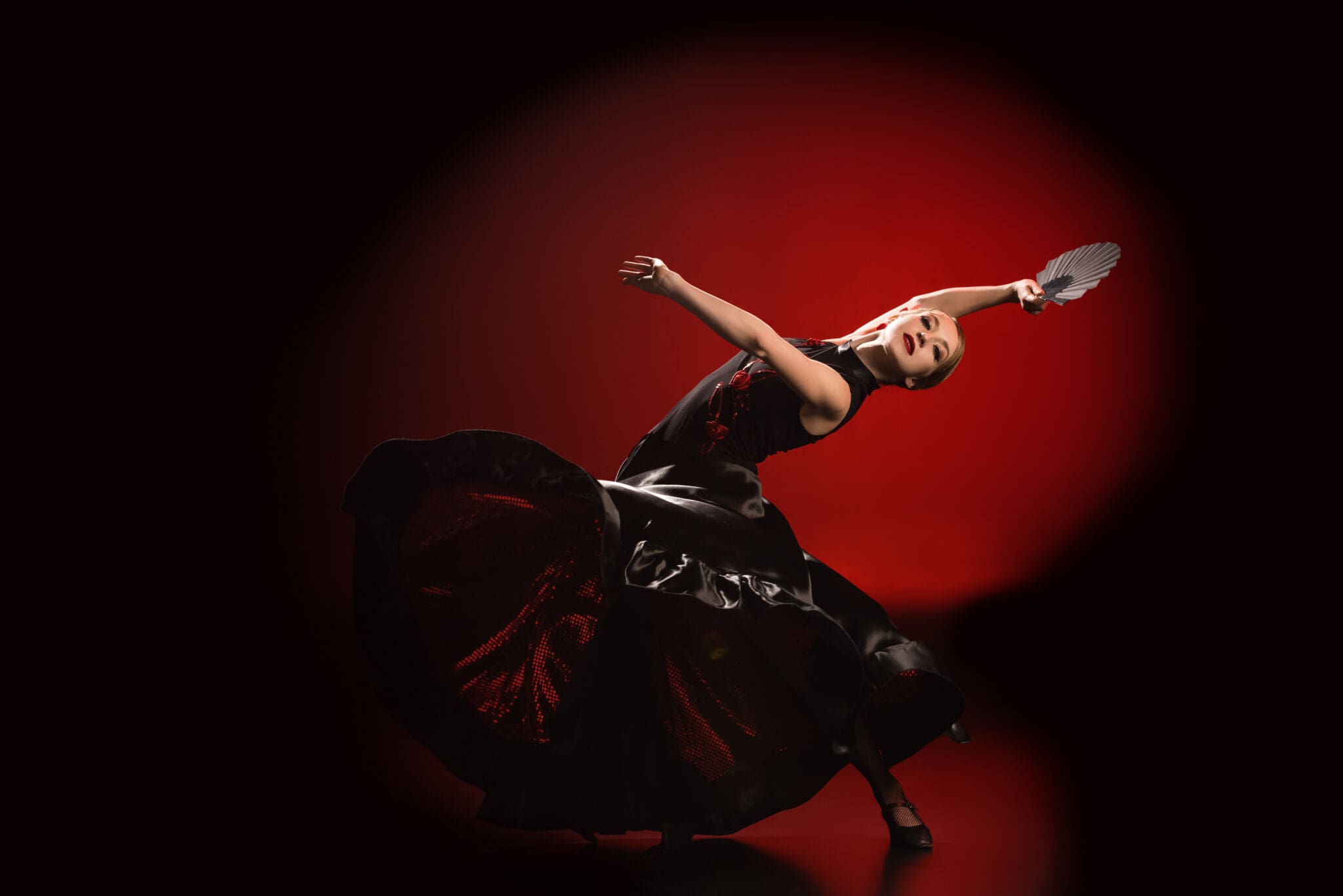
Updated On: April 04, 2024 by Raghda Elsabbagh
Fado, Flamenco, and Folk music are the melodious expressions that define the cultural identity of Portugal and Spain. Each genre carries with it a story, a heritage that transcends generations and becomes a deep-rooted part of the national consciousness. Fado, often described as the Portuguese lament, is a musical genre that captures the essence of ‘saudade’, a feeling of nostalgic longing, through its soul-stirring melodies. In Spain, Flamenco is the fiery expression of life, encompassing dance, song, and music, known for its emotional intensity and rhythmic complexity.
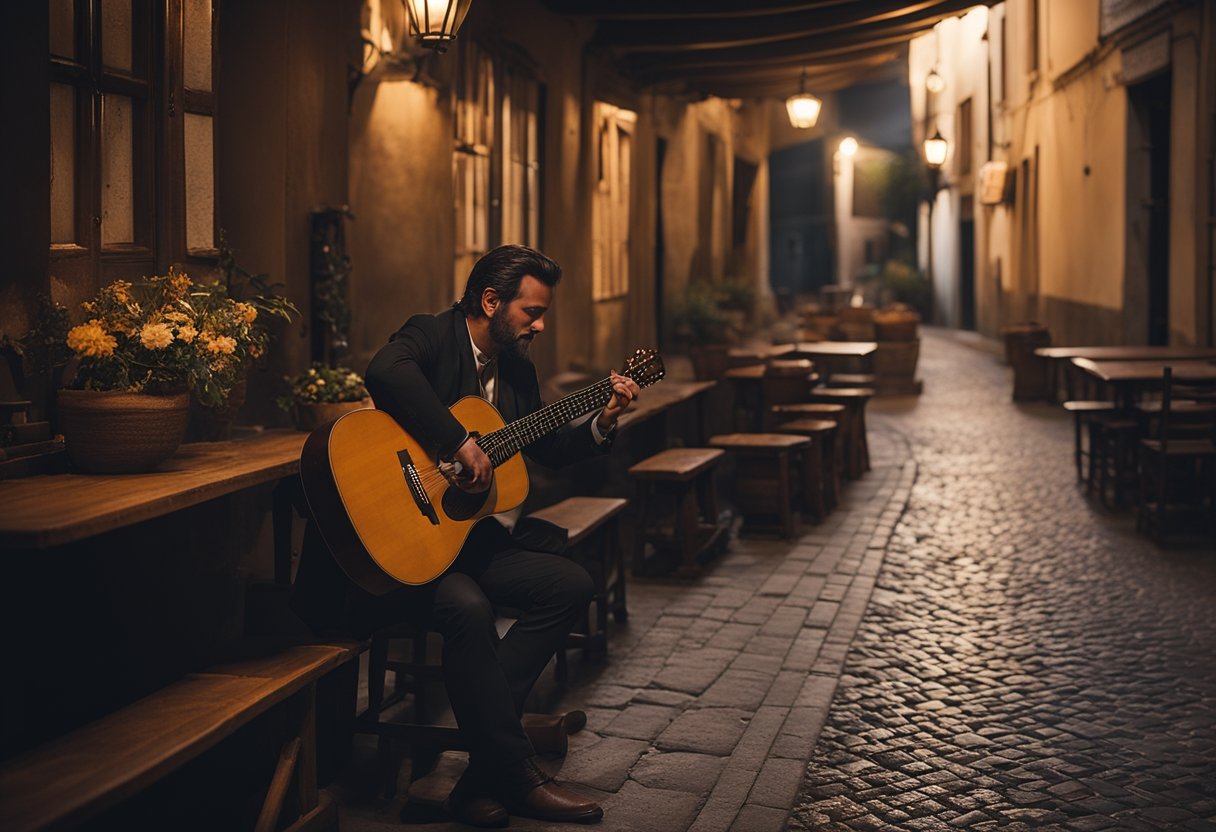
Iberian music is more than just sound; it is a narrative of the people. The unique sounds of the Portuguese ‘guitarra’ and the Spanish ‘cante jondo’ reveal the nuanced traditions that differ not only between the two countries but also within their regions. From the intimate fado houses in Lisbon to the passionate flamenco tablao in Andalusia, these genres provide a window into the vibrant musical landscapes of Portugal and Spain. The folk traditions, often overlooked, carry the tales and the history of a people whose identity is as diverse as the tunes that fill their air.
Table of Contents
The Essence of Fado
In our exploration of Fado, we shine a light on its poignant history, its cultural impact in Portugal, and the remarkable vocalists—fadistas—who have become the heartrending voices of this treasured genre.
Roots and Evolution
Fado originated in the early 19th century in Portugal, blossoming from the historic quarters of Lisbon, such as Alfama and Mouraria. As a music form stemming from the experiences of sailors, it encapsulates feelings of longing, or saudade, often reflecting life’s inescapable fate and underscoring the Portuguese soul. The mournful melodies carried by the Portuguese guitar have seen Fado evolve, with Coimbra offering a distinctive style known for its scholarly roots.
Fado’s Cultural Significance
Acknowledged by UNESCO as an Intangible Cultural Heritage, Fado not only conveys the essence of Portuguese identity but also acts as a vessel for cultural expression. The quintessential Fado houses of Lisbon serve as sanctuaries where locals and visitors come together, united by the earnest performances that echo the centuries-old narratives of love, loss, and destiny. It’s within these intimate spaces that the soul of Portugal is laid bare for the audience to commune with.
Fadistas: The Voices of Fado
Prominent figures like Amália Rodrigues, affectionately regarded as the ‘Queen of Fado’, and contemporary voices such as Mariza have carried Fado beyond Portugal’s borders, introducing the world to the nation’s musical heart. These fadistas are more than mere performers; they embody the living history and emotional depth of Fado, channelling saudade into a shared human experience through their soul-stirring songs.
Guitarra Portuguesa
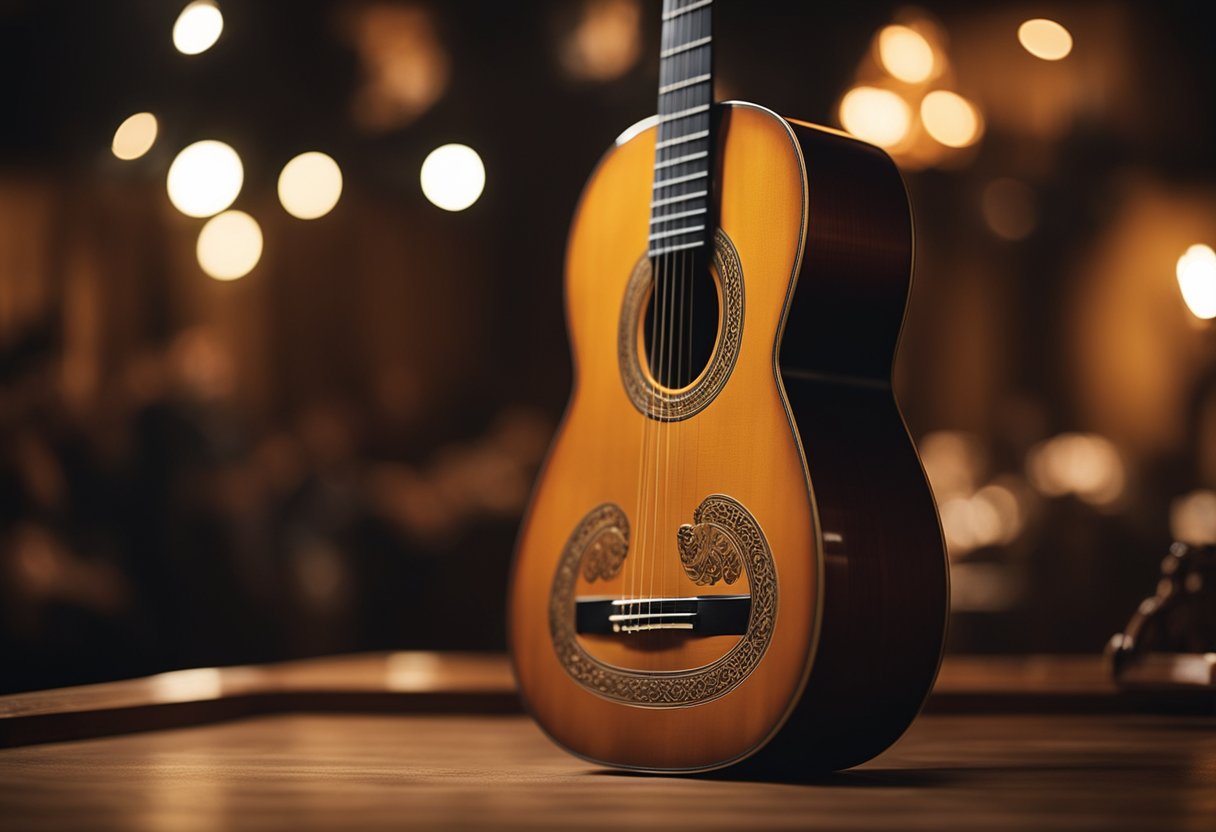
The Guitarra Portuguesa, or Portuguese guitar, is an iconic symbol of Portuguese culture, having a profound impact on the traditional music of the nation, particularly Fado. Revered for its unique sound and playing style, the guitarra Portuguesa holds a special place in the hearts of the people.
12-String Magic
The 12-string guitar, commonly known as the Portuguese guitar, is distinct from other guitars with its paired strings, which are usually tuned in unison or in octaves. These strings create a rich and resonant sound that has become synonymous with the soulful and poignant melodies of Fado music emanating from the intimate Fado houses of Lisbon and Porto. When played, each strum on this Portuguese 12-string guitar unfurls a wave of harmonious and lyrical timbres, making it an indispensable part of Portugal’s musical heritage.
Symbolism in Strings
The guitarra Portuguesa is not just a musical instrument; it carries the weight of deep cultural symbolism. Its strings encapsulate the essence of ‘saudade’, a Portuguese term for a deep emotional state of nostalgic longing for something or someone that one cares for and which is lost. This instrument is not merely a medium for melody but serves as a vessel through which the stories and emotions of a people are conveyed. It is a significant emblem of Portuguese identity and the enduring charm of the nation’s folk traditions.
Fado Venues
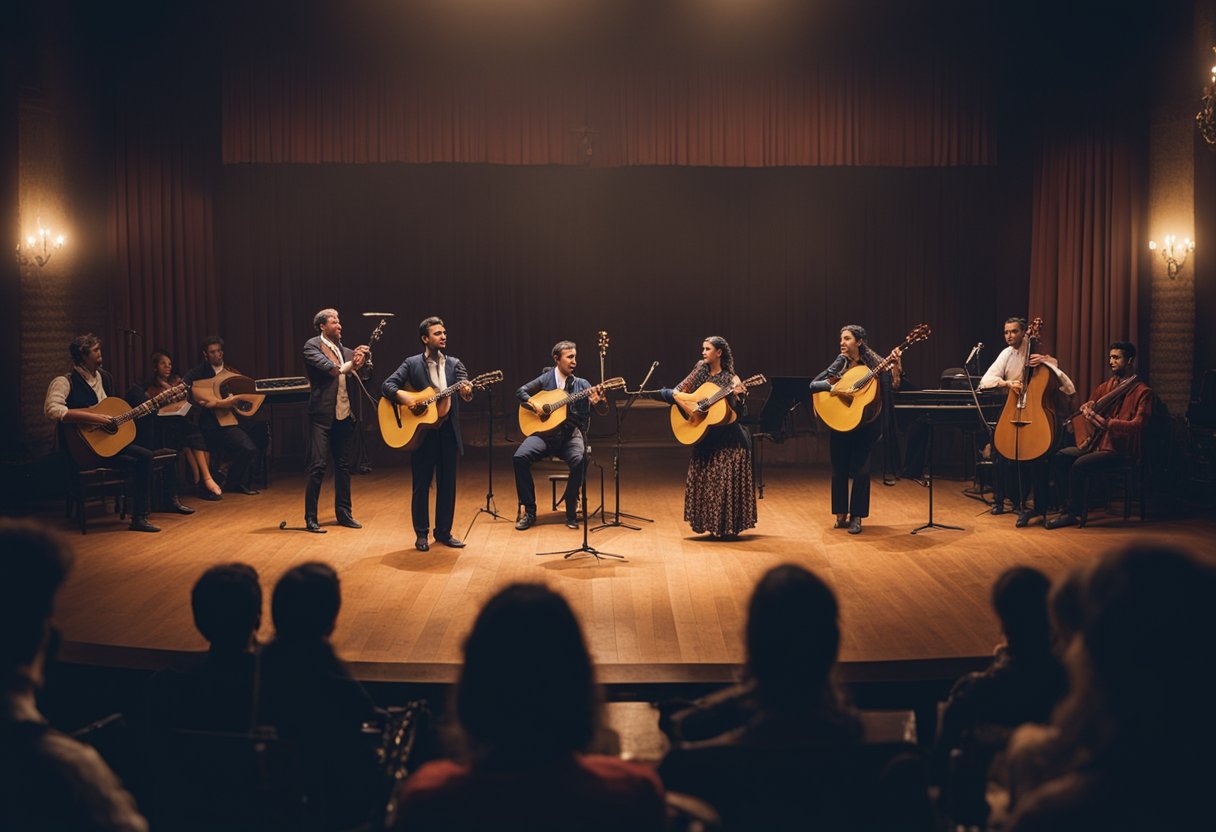
Fado music offers a profound sense of place and tradition in Portugal, with Lisbon being the heart of the fado scene. The venues range from intimate bars to historic fado houses, each with its own charm and story.
Cultural Hotspots in Lisbon
Lisbon is the cradle of fado, where barrios like Bairro Alto and Alfama brim with places to experience this soulful music. Destinations like Tasca do Chico and Clube de Fado stand out as cultural hotspots. Tasca do Chico, a small bar in Bairro Alto, is where Fado lives and breathes. Here, amateur and professional fadistas alike share their songs, enveloping the audience in a blanket of melancholy and nostalgia.
- Tasca do Chico: A Bairro Alto gem with impromptu performances.
- Clube de Fado: Offers a sophisticated fado experience near the Lisbon Cathedral.
These spaces are more than just venues; they are the keepers of Portuguese heritage.
Beyond the Capital: Fado Across Portugal
Outside Lisbon, the National Pantheon area and other regions offer their unique spin on fado. Whether in a tavern in Porto or a bar along the Douro, fado connects us to Portugal’s soulful past and present.
- Fado houses: Throughout the country, each one celebrates local history.
- Povo: A bustling Lisbon fado venue known for contemporary fado voices.
In these venues, the time-honoured tradition of fado is preserved and celebrated across Portugal.
Regional Fado Styles
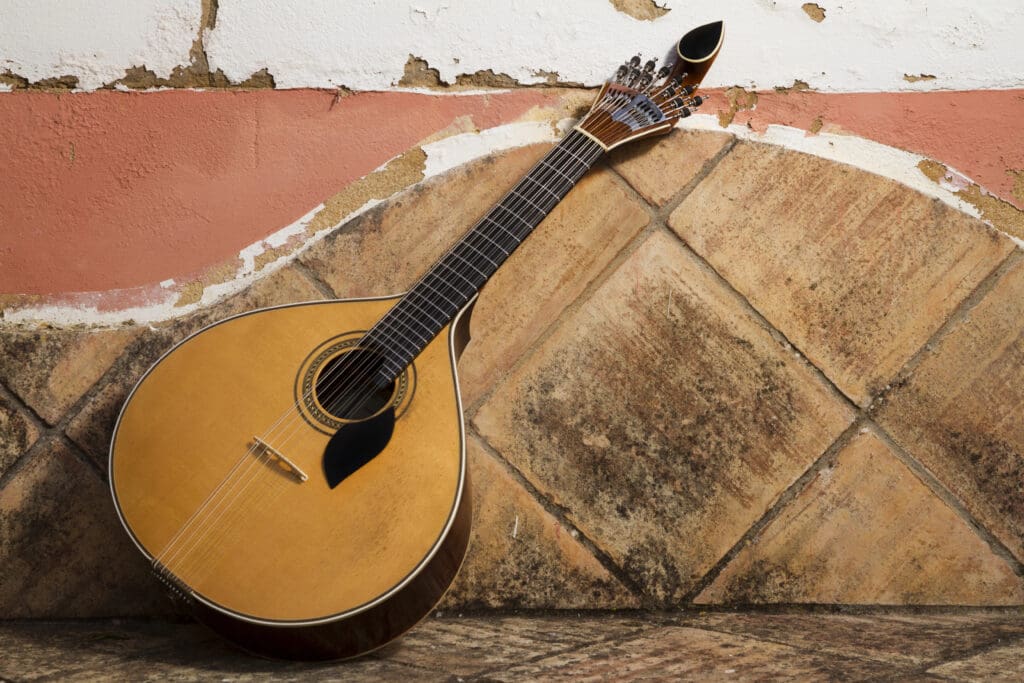
Fado music has evolved into distinct regional styles within Portugal, notably from Lisbon and Coimbra. Each carries its own historical and cultural significance that contributes to the genre’s rich tapestry.
Lisbon vs. Coimbra
Lisbon Fado is known for its emotionally charged performances, typically featuring both male and female soloists. The style is deeply ingrained in the urban culture of Lisbon, with its roots tracing back to the early 19th century. The mournful melodies and the soulful lyrics often express a yearning and nostalgia for things past, known as “saudade.”
Coimbra Fado, contrasting with Lisbon’s style, is traditionally performed by male singers, often connected to the city’s university students. Coimbra Fado has a more refined and academic tone. Performances are less frequent and typically more formal, often occurring in academic settings or during ceremonial events. The lyrics can be poetic and are sometimes influenced by medieval troubadour traditions.
Influences Beyond Borders
While Fado has its origins in Portugal, it has absorbed and integrated diverse musical influences over time. Brazilian rhythms, African music from Mozambique, and various other global sounds have added layers to Fado, enriching it beyond its traditional framework. Still, whether in Lisbon, Coimbra, or beyond Portugal’s borders, Fado remains a poignant representation of the Portuguese soul.
Stylistic Elements of Flamenco
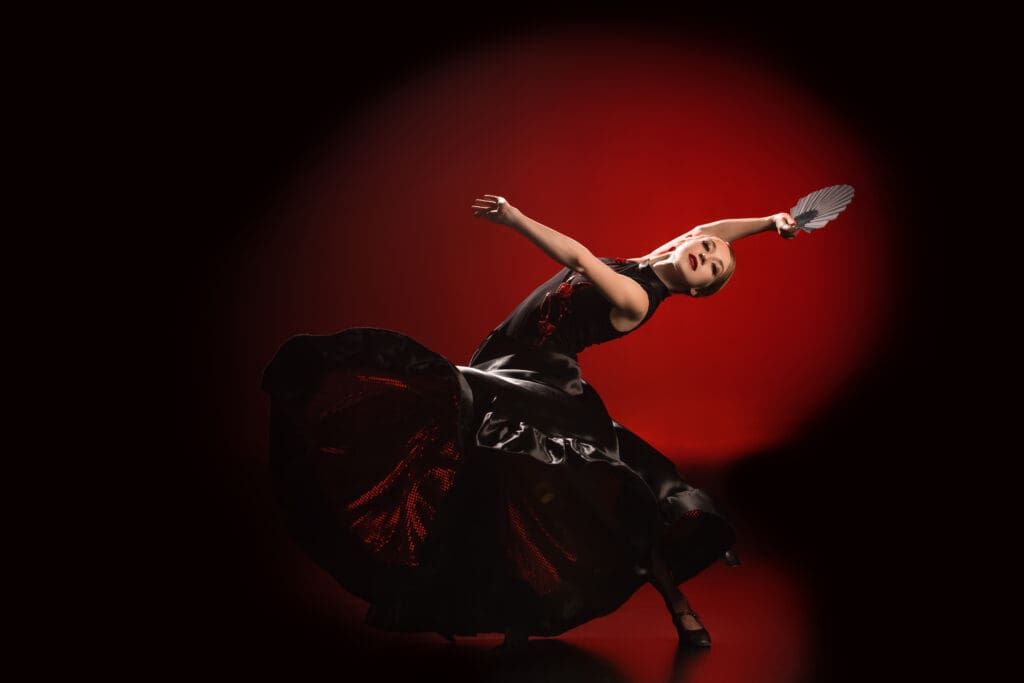
Flamenco, with its powerful expressions of love, loss, and fate, encapsulates the soul of Southern Spain. Its stylistic elements are a testament to the region’s cultural past and present.
Flamenco’s Fusion of Cultures
Flamenco is a poignant reflection of Spain’s diverse culture, with origins rooted in Andalusian history. This art form is a blend of various traditions, including influences from the Roma people, historically known as Gitanos. The fusion of these cultures is witnessed in every aspect of Flamenco, from singing and vocals to the intricate dance movements that tell a story of identity and passion.
Instrumentation and Technique
At the heart of Flamenco is the guitar, employing both complex strumming and delicate plucking to convey deep emotions. The technique of playing the Flamenco guitar is highly distinctive and requires not just skill but also a deep connection with the music. Vocalists use their voices to evoke feelings of fate and profundity, while dancers stomp their feet with precision, drawing the audience into a narrative of passionate intensity. Each element works in harmony to deliver an authentic Flamenco experience that resonates with every strum and step.
Flamenco Through Time

Flamenco, an art form deeply integrated into the Spanish soul, embarks on a historical journey that leads it onto the world stage, where UNESCO recognises it as part of humanity’s intangible cultural heritage.
Historical Journey
Flamenco’s origins are as complex and passionate as its performances. It began within the Mouraria, a melting pot of cultures in Andalusia, Spain, where the fusion of Romani, Arabic, and Jewish influences created a unique art form. By the 19th century, it had become a hallmark of Spanish culture, with cante (singing), toque (guitar playing), and baile (dance) narrating the stories of Spanish life.
Flamenco on the World Stage
Our recognition of Flamenco’s global influence was cemented on 16 November 2010, when it was officially inscribed on the UNESCO Representative List of the Intangible Cultural Heritage of Humanity. This inclusion not only celebrates Flamenco’s contribution to the arts but also ensures its preservation for future audiences. Across Europe and beyond, Flamenco continues to resonate with an international audience, evoking the maritime heritage of Spain and the depth of its people’s experiences.
Iconic Flamenco Styles
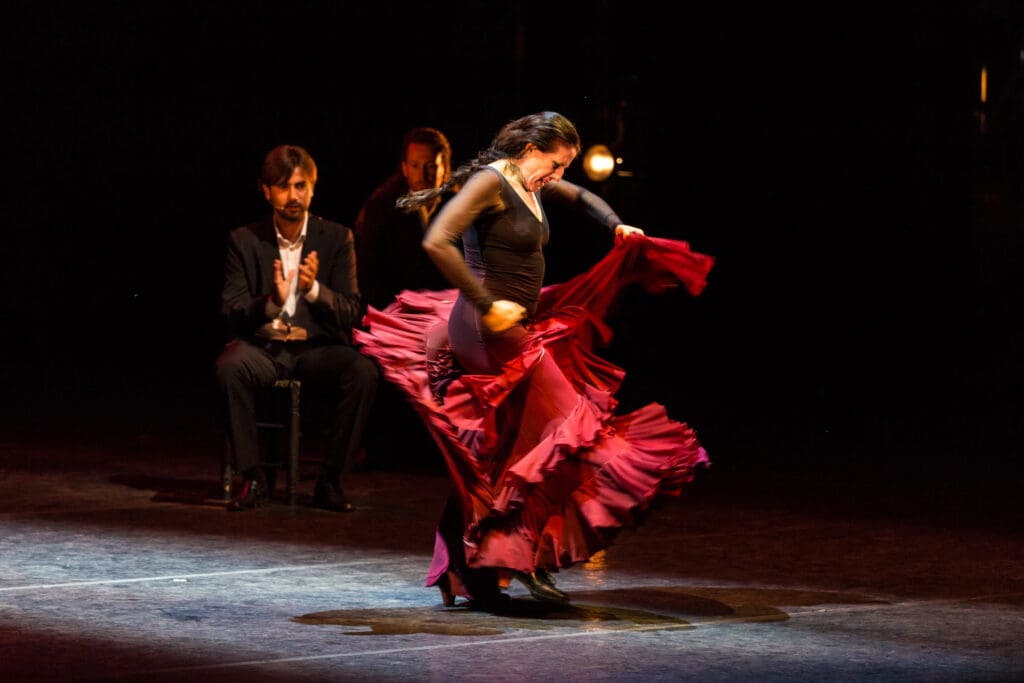
Flamenco, with its intense emotions and meticulous performance, forms a cultural cornerstone in Spain. Its magnetism is in its ability to convey the profound feelings of saudade, capturing the complexity of fate and origin through song, dance, and music.
The Cante
At the core of Flamenco is The Cante, or the song, imbued with the weight of an ancient tradition. It’s the voice of Flamenco, expressing a gamut of emotions from joy to sorrow, reflecting the soul of the performer. We categorise these songs into various palos or styles, which include the deep and profound cante jondo and the lighter cante chico.
The Baile
Next, The Baile or the dance is a visually captivating aspect where the dancer’s body becomes an instrument of storytelling. The traditional zapateado footwork, with its rhythmic stomping and the graceful arm and hand movements called Flores, are intrinsic to the Baile. It’s a powerful performance where dancers articulate everything from despair to exuberance, often accompanied by handclaps or palmas.
The Toque
Finally, The Toque refers to the Flamenco guitar playing that cradles the entire Flamenco performance. The guitarist must not only master traditional techniques such as rasgueado and picado but also empathise deeply with the singer and dancer, forming a trinity of expressions. This harmonious synergy can elevate the Toque from mere accompaniment to a leading force that guides the mood of the entire act.
The Toque also incorporates various other instruments like cajón and castanets, but the guitar remains central, resonating with the audience’s heartstrings.
Flamenco, through these three elements, continues to be a testament to cultural storytelling, echoing the essence of human experiences and societal roots. It’s an art form that beckons us to feel as deeply as we dare, drawing us into the compelling narrative of life’s intricacies.
Cultural Institutions of Folk
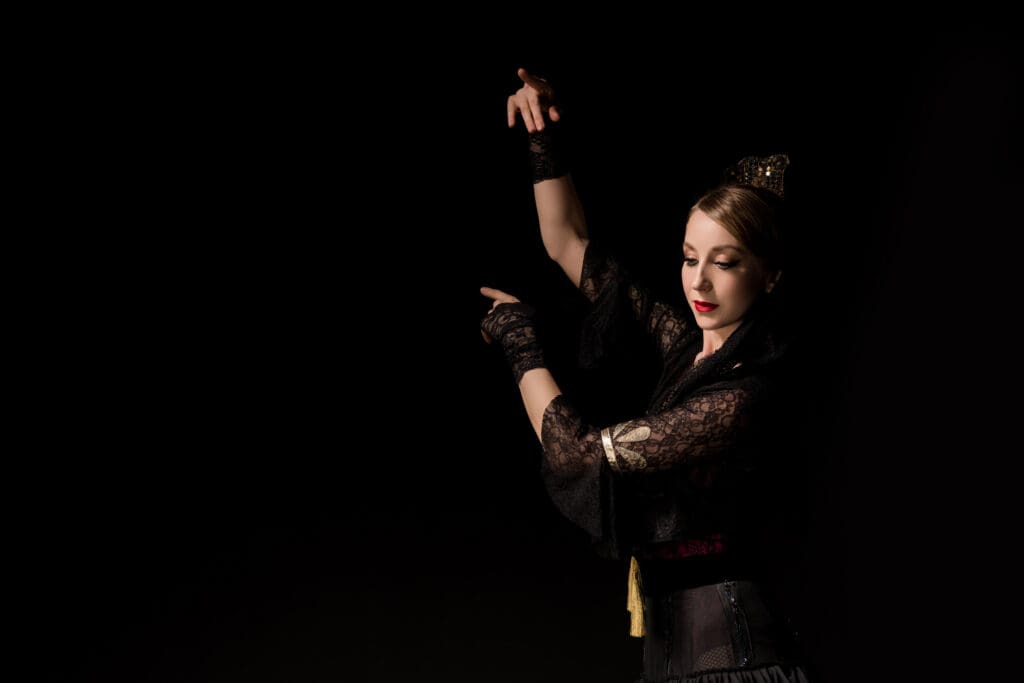
In the tapestries of European folk traditions, Portugal and Spain stand out with their rich musical legacies that are an intricate part of their cultural identity and societal fabric.
Folk Music’s Role in Society
Fado and flamenco have transcended their origins to become cultural icons within their respective societies. In Portugal, fado is the mirror of the Portuguese soul, reflecting themes of destiny, sorrow, and longing, or ‘saudade’. Similarly, in Spain, flamenco is a fervent expression of life, with its deep emotional intensity resonating within the community. Both genres serve as societal pillars, providing a sense of identity and continuity.
Preserving Tradition in the Modern Age
Our commitment to preserving these folk traditions goes beyond mere performance; it is about safeguarding our culture for future generations. Initiatives like UNESCO’s Intangible Cultural Heritage list help intrinsic customs persist in the modern age. We play our part by participating in festivals, patronising traditional flamenco tablaos or fado houses, and educating the young about the importance of these art forms to ensure they remain at the heart of our communities.
Fusion Forms
In the rich tapestry of Iberian music, innovative fusion forms have emerged, blending various musical influences from different cultures, including Portugal, Spain, Brazil, and France. These hybrid styles marry the deep-rooted traditions of Flamenco and Fado with contemporary sounds.
Blending Musical Worlds
The fusion of Flamenco and Fado with other musical genres represents a dynamic and innovative step in the evolution of music. In Portugal and Spain, artists have been merging these traditional sounds with elements from Brazil’s samba and bossa nova, creating a new genre that resonates with a modern audience. This process not only preserves the essence of the original music but also introduces it to new listeners, ensuring its progress.
Contemporary Folk Influences
The impact of folk music from France and other countries on the Iberian Peninsula has led to the birth of fresh, contemporary styles. These innovative influences offer a different perspective, infusing local music with new textures and rhythms. Through this musical experimentation, we see a progressive dialogue between traditional and modern, the past and the present, shaping the future soundscape of both Portugal and Spain.
External Influences on Iberian Music
Iberian music, including the soulful sounds of Fado and Flamenco, has been deeply shaped by a history of external influences that have contributed to its richness and diversity.
African and Brazilian Elements
We can look at the rhythm and expressive depth of Iberian music to see the influence of African and Brazilian cultures. For example, in Portugal, the mournful melodies and poignant lyrics of Fado have been infused with rhythmic patterns and instruments that trace their roots back to Africa and former colonies like Mozambique. This creates a tapestry of sound that speaks to a long history of cultural exchange.
Brazil’s impact on Portuguese music is evident through genres like Bossa Nova, which share a distinctly Portuguese linguistic and emotional character yet are undeniably shaped by Brazilian beats and styles. The exchange is mutual, with Portuguese music also leaving its mark on Brazilian sounds, reflecting a shared heritage and linguistic bond.
The Interplay with European Genres
Moving north from the Iberian Peninsula, the musical dialogue echoes throughout Europe. Spain and Portugal have both absorbed and contributed to the musical narratives of the continent, integrating French sophistication and European classical traditions into their own music.
In Spain, the Flamenco guitar has adopted variations in technique reflective of classical European instruments. The evolution of Flamenco itself can be seen as a culmination of various European and Gitano influences, resulting in a distinctly Spanish product but one that is also a part of a broader European musical language.
Our music, much like our culture, emerges as a vibrant illustration of diversity, resilience, and the ongoing story of musical influence and cultural exchange that transcends the borders of nations.
Musical Landscapes of Portugal and Spain
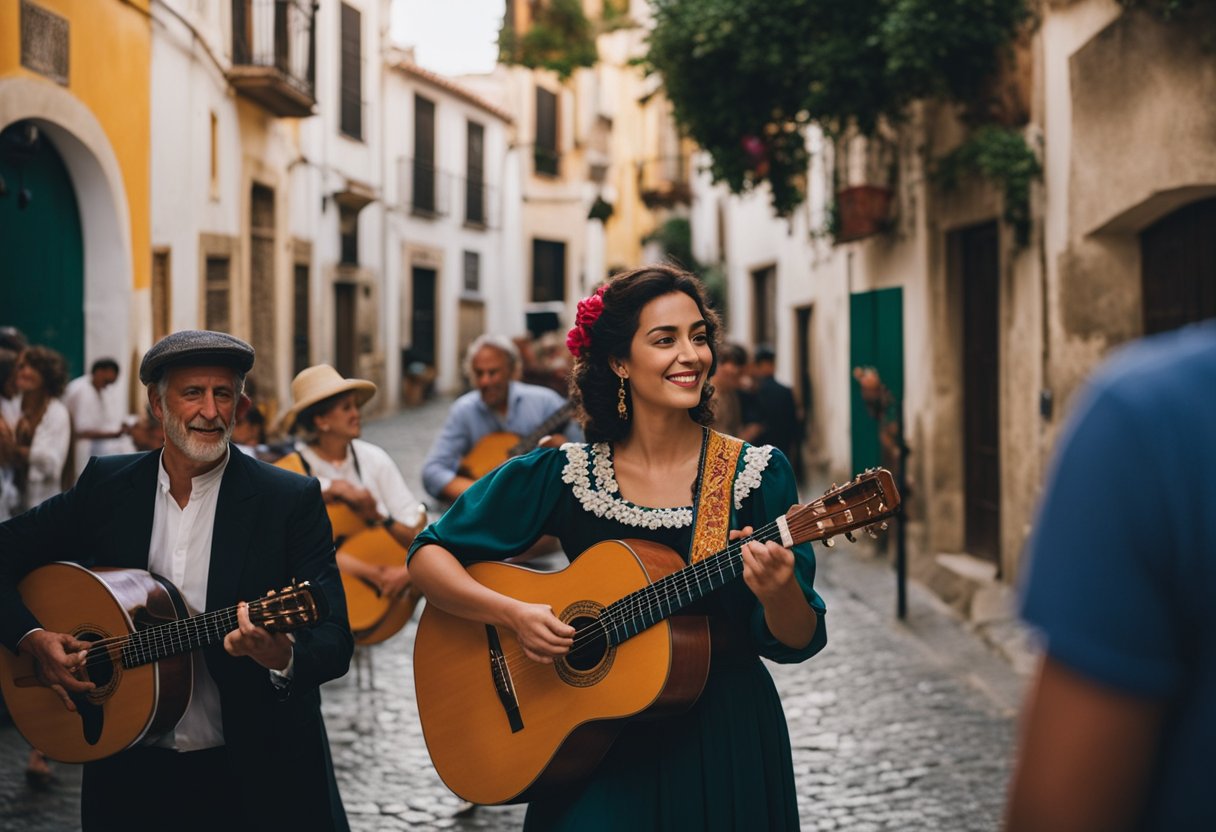
The musical traditions of Portugal and Spain are rich reflections of their respective national characters, deeply influenced by the diverse environments and the topography of the Iberian Peninsula.
Reflecting National Character
In Portugal, Fado stands as a poignant symbol of the national sentiment known as “saudade,” a feeling of deep longing and nostalgia. This genre, infused with the Lusophone identity, showcases soulful expression through its melancholic melodies and heartfelt lyrics. Meanwhile, Flamenco, the passionate art form hailing from Spain, embodies the fiery spirit and deep emotions of the Ibero-American community. Both countries cherish these musical genres, which have become emblematic of their cultural heritage.
Environments Shaping Music
The topography of Portugal and Spain has had a substantial impact on the development of regional music. The undulating hills, coastal cliffs, and urban landscapes of Portugal have given Fado its reflective quality. On the other hand, the diverse environments of Spain, from the arid plains of Andalusia to the rugged mountain ranges, have contributed to Flamenco’s intense rhythms and the diversity of Spanish folk music. These musical styles offer listeners a sonic journey through the varied landscapes and soul of their nations.
Frequently Asked Questions
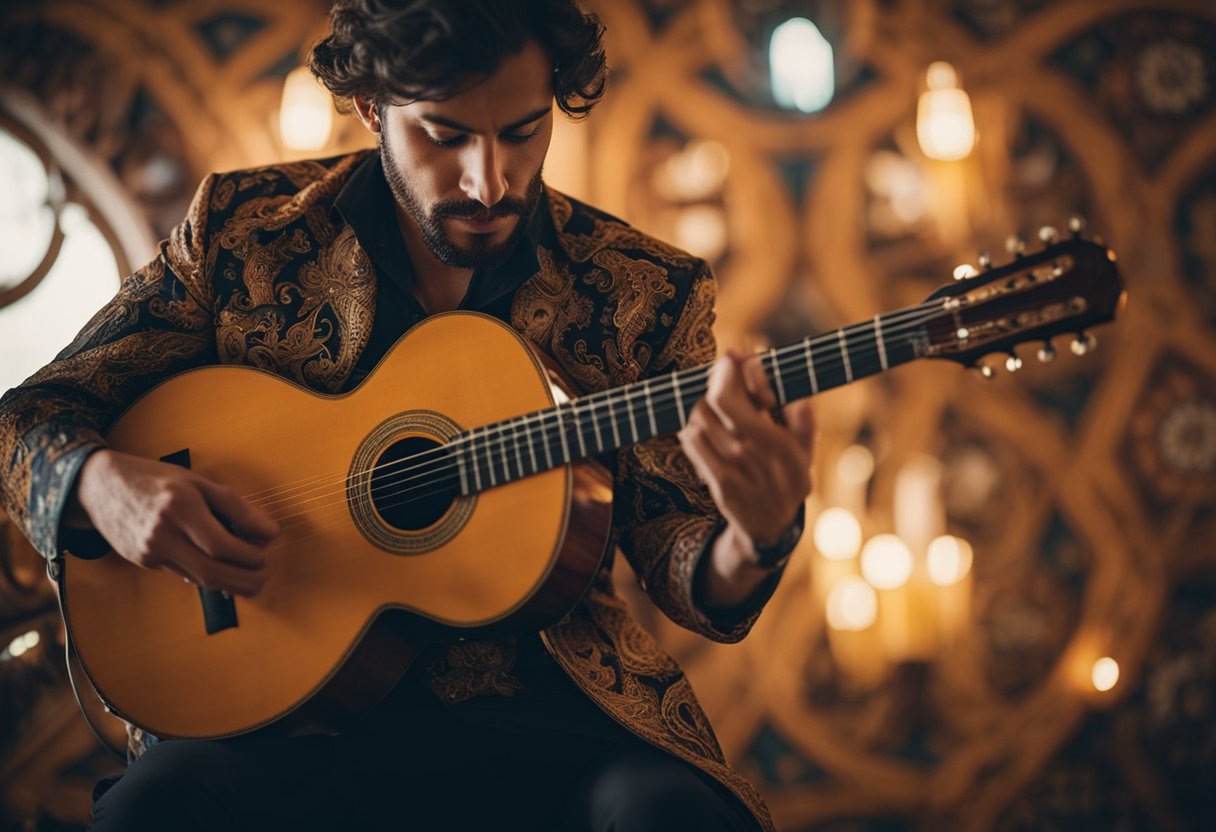
In this section, we’ll address some of the most common questions about the rich musical traditions of Portugal and Spain. From the defining characteristics of Fado to the historical influences on Spanish folk music, join us in exploring these captivating art forms.
What are the defining characteristics of Fado music from Portugal?
Fado music captivates with its profound sense of melancholy and longing, known as “saudade”. Its melodies are typically accompanied by the unique sound of the Portuguese guitar, and the heartfelt performances often convey stories of the sea, fate, and love lost.
How does Flamenco reflect Spain’s cultural heritage?
Flamenco is a vibrant expression of Andalusian culture, reflecting its Gypsy, Moorish, and Jewish influences through intense dancing, skilled guitar playing, and deeply emotional singing. The art form is celebrated for its intricate footwork, passionate performances, and the characteristic “duende”, a moment of profound emotion.
What are the typical instruments used in Portuguese folk music?
Portuguese folk music often utilises a variety of traditional instruments, including the cavaquinho, a small string instrument similar to a ukulele, the accordion, and the rebec, a type of fiddle. Each instrument contributes to the distinctively festive and rustic sound of Portuguese folk.
Where can one experience authentic Fado performances in Portugal?
Authentic Fado performances are best experienced in the Fado houses of Lisbon, particularly in the historic neighbourhoods of Alfama and Bairro Alto. These intimate venues offer live performances where the emotional power of Fado truly resonates with listeners.
Are there distinct regional styles within Spanish Flamenco?
Yes, there are several regional styles within Spanish Flamenco known as “palos”. These vary widely and reflect the diverse cultures of Spain, with some of the most well-known styles being Soleá, Bulerías, and Seguiriyas, each with its own rhythm, mood, and regional roots.
What historical influences have shaped traditional Spanish folk music?
Traditional Spanish folk music has been shaped by a myriad of influences over the centuries, including Roman, Moorish, Sephardic Jewish, and even Celtic cultures. These influences have contributed to a rich tapestry of musical styles that vary from region to region, each telling its own story of Spain’s complex history.



